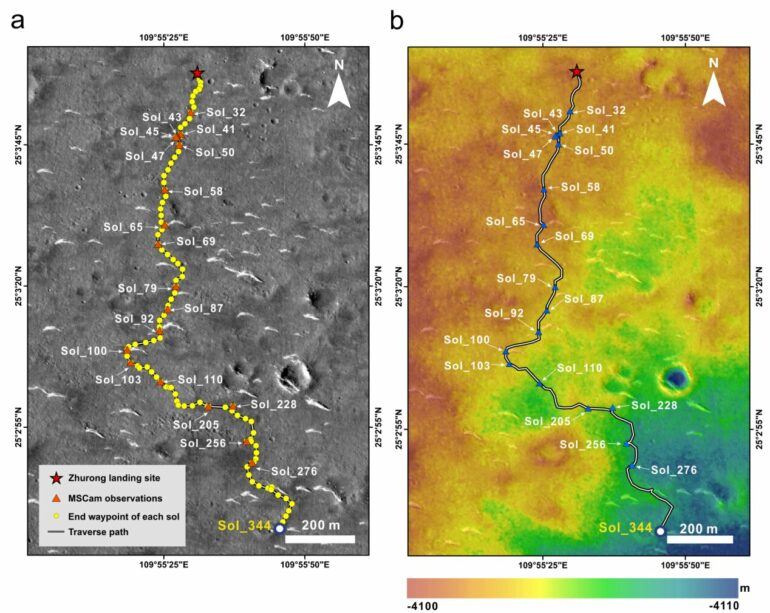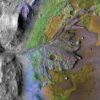An international research team led by Professor Long Xiao from the School of Earth Sciences of China University of Geosciences (Wuhan) has discovered the presence of marine sedimentary rocks on the surface of Mars for the first time by comprehensively analyzing the scientific data obtained by the multispectral camera (MSCam) carried by the Zhurong rover. The relevant research results were published in the journal National Science Review under the title “Evidence for Marine Sedimentary Rocks in Utopia Planitia: Zhurong Rover Observations.”
Currently Mars is cold and dry, lacking water and traces of life, but the Martian environment billions of years ago may have been very different. Past studies have proven that there was a large amount of liquid water on Mars in the early days, and the paleo-ocean hypothesis was proposed through landform analysis of satellite images and numerical simulation.
It has been proposed that the paleo-ocean area in the northern lowlands formed a special marine sedimentary geological unit, called the Vasitas Borealis Formation (VBF), but this proposition has lacked the support of in-situ data. Therefore, whether there was an ocean in the northern plain of Mars has been the focus of controversy for decades.
In 2021, the Zhurong rover carried by China’s Tianwen-1 Mars mission successfully landed on the southern edge of the Utopia Plain in the eastern part of the northern plain of Mars. Part of the mission was to search for any possible evidence for or against the existence of an ancient ocean, which may have hosted early life on Mars.
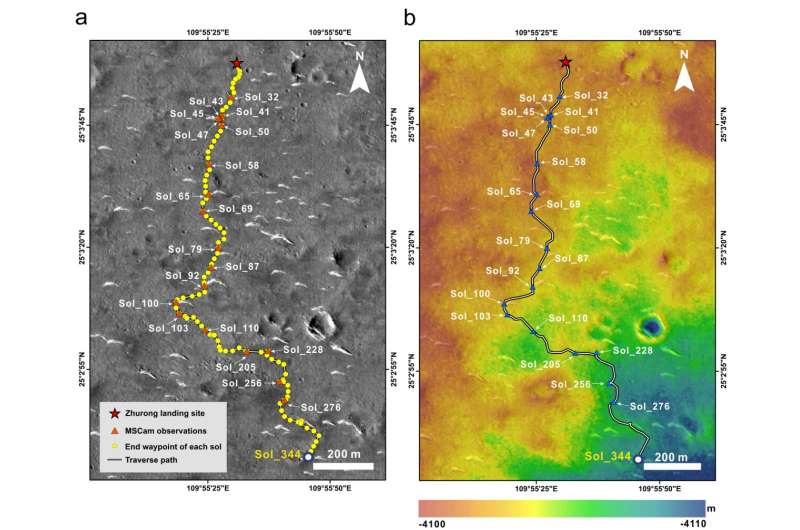
The base map of a is HiRIC (HX1_GRAS_HIRIC_DIM_0.7_0004_251515N1095850E_A), b is HiRISE DEM (DTEEC_069665_2055_069731_2055) overlain on the HiRIC. The elevation difference from the landing site to the break point (Sol_344) is about 5 meters. © Science China Press
After landing, the Zhurong rover headed south towards potential coastline areas, observing the exposed Vasitas Borealis Formation along the way. Zhurong traveled about 1,921 meters, and used different imaging and analysis systems to conduct detailed in-situ observations of outcrops and surface rocks. The navigation and terrain cameras obtained 106 sets of panoramic images, which recorded in detail the surface morphology and structural characteristics of many rocks near the route of the Zhurong rover.
The research team examined the photos sent back by the rover’s on-board camera and found that the exposed rocks featured bedding structures, which are significantly different from the common volcanic rocks on the surface of Mars, and also different from the bedding structures formed by aeolian sand deposition. The structures indicated bidirectional flow characteristics consistent with low-energy tidal currents in Earth’s littoral-shallow marine environment.
Based on the rock images obtained by MSCam, the research team analyzed in detail the surface structure of the rocks in the inspection area of the Zhurong rover. Since the observed rocks are all located in the Zhurong inspection area, the research team named the geological unit it represents the Zhurong Member. During the study, the research team found that the rocks in the section typically retained local lens-shaped cross-bedding fabrics, mainly composed of a variety of small-scale cross-bedding, accompanied by a small amount of lens-shaped flaser bedding and sedimentary structures of small channel structures.
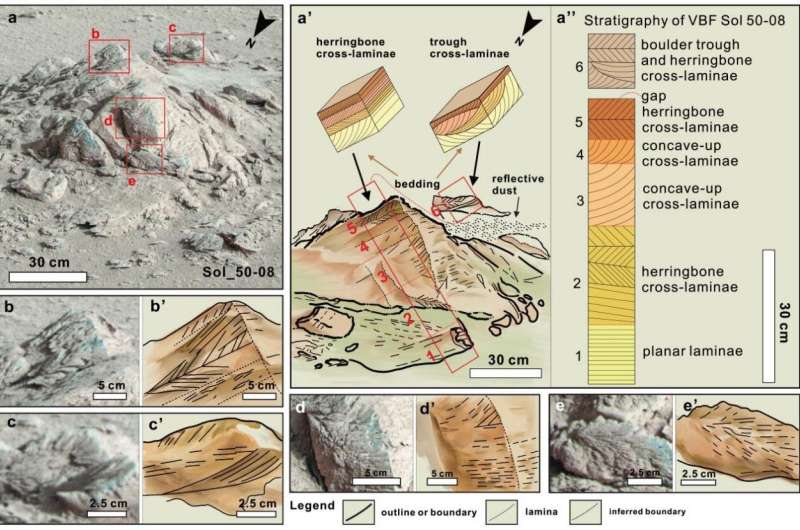
Block diagrams show interpreted sedimentary structures. The boulder is about 110 cm across and preserves a series of left-dipping planar surfaces separating 2-10 cm thick tabular units interpreted to be primary sedimentary bedding and is generally consistent with that on the surrounding ground. The greenish tint on some surfaces is due to color saturation of the sensors, and not real. The beds have internal laminations that differ from bed to bed. These features are used to interpret the primary depositional environment. Note that the boulder is locally sculpted by wind, in places covered by wind-blown dust or sand, and possibly affected by chemical weathering or cementation. a”. Stratigraphic section drawn perpendicular to bedding along the front face of the outcrop, and placing boulder c on top, as it appears to strike with a small missing gap. The section is divided into six units of planar, herringbone, convex-up, and trough cross-laminated layers, suggestive of deposition by bi-directional subaqueous currents. Details of features from red boxes on panel a. b. Features interpreted as herringbone cross-laminae formed by bipolar current directions, typical of alternating currents. c. Features interpreted as trough cross-lamina from a separate boulder in the background, representing bipolar current directions, overlain by planar cross-laminated sand. Boulder is possibly out of place or even upside down, but appears to have similar orientation as the main boulder. d. Features interpreted as planar bedding visible in 3D around a corner in the boulder, overlain by a concave cross-laminated unit. e. Features interpreted as herringbone cross-lamina, strongly etched by wind, forming a pseudo-fan shape. © Science China Press
Among them, the layers that make up the cross-bedding overlap and tilt in two opposite directions, indicating a bidirectional paleocurrent environment. In addition, since the thickness and grain size of the strata are largely different in different directions, it indicates that there are differences in the intensity of paleocurrents in the two directions.
This bidirectional water flow pattern is usually formed by the fluid action with periodic flow direction changes, which is not common in eolian and fluvial environments, but is common in the littoral-shallow sea environment of Earth. Compared with Earth, Mars has only two small satellites, which makes its surface have a low-energy tidal system, and only small-scale bedding structures can be formed in this tidal environment.
In addition, the bedforms and sedimentary structures identified in the study include evidence supporting aqueous flow rather than eolian deposition.
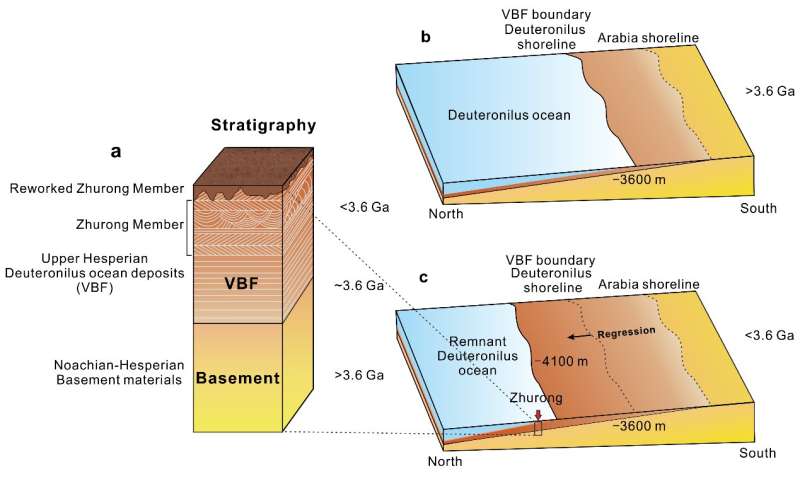
(a) Schematic stratigraphic column of the Zhurong landing site in Utopia Planitia and proximity to interpreted shoreline. The -3600 m contour in (b & c) represents the boundary of the Vastitas Borealis Formation (VBF), a smooth lowland unit consisting of sedimentary deposits of a possible ancient oceanic water body before 3.6 Ga . After that, ocean regression may have resulted in a shallow marine environment near the current position of the Zhurong rover (c, red arrow). © Science China Press
The team’s observational results of the Zhurong Member rocks in this study are the first direct in-situ evidence detected to support the existence of ancient oceans in the northern plains of Mars. The location of the landing site of Zhurong indicates that the observed sedimentary structures may have formed during the regression of the northern plain paleo-ocean.
The sedimentary structures found in the Vasitas Borealis Formation provide new insights into the early history of Mars. The in-depth exploration by Zhurong in this area and future sample return will deepen our understanding of the habitability of Mars and the preservation of microbial life traces.
More information:
Long Xiao et al, Evidence for marine sedimentary rocks in Utopia Planitia: zhurong rover observations, National Science Review (2023). DOI: 10.1093/nsr/nwad137
Provided by
Science China Press
Citation:
In-situ observations of marine sedimentary rocks suggest ancient northern ocean on Mars (2023, May 22)
